| dc.contributor.advisor | Bøhn, Thomas | |
| dc.contributor.author | Cuhra, Marek | |
| dc.date.accessioned | 2015-07-28T08:04:56Z | |
| dc.date.available | 2015-07-28T08:04:56Z | |
| dc.date.issued | 2015-06-09 | |
| dc.description.abstract | Transgenic glyphosate tolerant soybeans are constituents of an industrial production system with specific agricultural practices and supplementary agrochemicals as interwoven additional elements. Thus the material produced should not be seen as an isolated product of a specific modified genotype but rather as a product of a tailored agriculture system.
This globally dominant crop has been in open cultivation since 1995 and is still predominantly based on hybrid varieties of the GTS-40-3-2 transgenic event soybean (Roundup-ready soybean) in combination with glyphosate herbicide co-technology.
The herbicides were tested for acute and chronic toxicity in a D. magna animal model. It was found that the ecotoxicity is more potent than what was previously assumed in regulatory assessments based on information provided by chemical industry. Notably, it was found that low concentrations of Roundup induce reproductive failure in D. magna (paper I).
Laboratory analysis show systematic differences which characterize these products. Substantial ppm-levels of glyphosate residues were found to be systematically present in all tested samples of Roundup-ready soybean (paper II).
Life-long feeding-study with soybean-feed in D. magna demonstrated that overall animal performance measured as growth and reproduction was significantly affected by soy-meal diets. Animals fed transgenic soybean-meal showed significantly reduced growth and reproduction (paper III).
The research presented in papers II, II and IV contributes to a body of evidence indicating that directly and indirectly measurable material differences between transgenic and conventional cultivars are significant qualitative aspects, which challenge the concept of substantial equivalence. The traditional methodology for testing whether transgenic plants are substantially equivalent to their unmodified origins should be adjusted based on these findings.
Finding that exposure to low-levels of glyphosate or Roundup in the environment will impair D. magna growth and reproduction, indicates that the negative effects seen in feeding-studies could be caused by toxic effects from glyphosate residues. | en_US |
| dc.description.doctoraltype | ph.d. | en_US |
| dc.description.popularabstract | Forskningen viser at genmodifisert glyfosat-tolerant soya, - bedre kjent som Roundup-ready soya -, har egenskaper som gjør denne soyatype vesentlig forskjellig fra umodifisert soya. Roundup-ready soya inneholdt store mengder glyfosat, som er sprøytemiddelrester fra dyrkingen.
I foringsforsøk ble det videre påvist at Roundup-ready soya gir dårligere overlevelse, vekst og reproduksjon enn vanlig industrielt dyrket umodifisert soya. Økologisk soya er et vesentlig bedre fôrmateriale for forsøksdyrene.
I et etterfølgende foringsforsøk ble 8 grupper forsøksdyr foret forskjellige innhøstinger av Roundup-ready soya. Resultatene viser at med høyere nivå av sprøytemiddelrester i foret, blir m.a. dyrenes kjønnsmodning forsinket.
Dette indikerer at Roundup-ready soya (som er dominerende ingrediens i dyrefor på verdensbasis) er vesentlig forskjellig fra umodifisert soya. Negative aspekter kan i hovedsak knyttes til innholdet av glyfosat, som sees å innvirke negativt på forsøksdyrene.
Dagens bransjebestemte politikk, som ekskluderer bruk av Roundup-ready soya i for til Norsk oppdrettslaks, anbefales opprettholdt.
Avhandlingen presenterer i tillegg en gjennomgang av en rekke studier utført av industriens forskere og problematiserer det forhold, at nevnte forskere ikke har undersøkt problemstillinger rundt sprøytemiddelrester. | en_US |
| dc.description.sponsorship | NFR - Forskningsrådet | en_US |
| dc.description | Paper III of this thesis is not available i Munin:
<br> III: M. Cuhra, T. Traavik & T. Bøhn. 2014. 'Life cycle fitness differences in Daphnia magna fed Roundup-Ready soybean or conventional soybean or organic soybean', available in <a href="http://dx.doi.org/10.1111/anu.12199">Aquaculture Nutrition</a> | en_US |
| dc.identifier.uri | https://hdl.handle.net/10037/7869 | |
| dc.identifier.urn | URN:NBN:no-uit_munin_7457 | |
| dc.language.iso | eng | en_US |
| dc.publisher | UiT The Arctic University of Norway | en_US |
| dc.publisher | UiT Norges arktiske universitet | en_US |
| dc.rights.accessRights | openAccess | |
| dc.rights.holder | Copyright 2015 The Author(s) | |
| dc.rights.uri | https://creativecommons.org/licenses/by-nc-sa/3.0 | en_US |
| dc.rights | Attribution-NonCommercial-ShareAlike 3.0 Unported (CC BY-NC-SA 3.0) | en_US |
| dc.subject | VDP::Medical disciplines: 700::Health sciences: 800::Nutrition: 811 | en_US |
| dc.subject | VDP::Medisinske Fag: 700::Helsefag: 800::Ernæring: 811 | en_US |
| dc.title | Ecotoxicological assessment of
Roundup-ready soybean agriculture
investigated in a D. magna model | en_US |
| dc.type | Doctoral thesis | en_US |
| dc.type | Doktorgradsavhandling | en_US |


 English
English norsk
norsk




